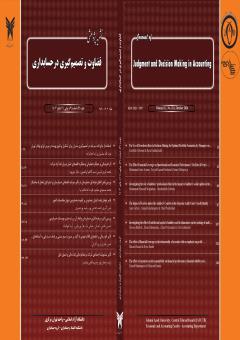The Use of Drawdown Beta in Decision-Making for Optimal Portfolio Formation by Managers on the Tehran Stock Exchange
Subject Areas :REZA HADDADZADEH 1 , ezatollah abbasian 2
1 -
2 - Associate Professor in Economics, Department of Public Administration, Faculty of Management, University of Tehran,
Keywords: Expected Regret of Draw down, Conditional Drawdown-at-Risk, Capital Asset Pricing Model, Standard Beta, Negative ERod, Downside Beta,
Abstract :
In this article, a new and dynamic metric called Expected Regret of Drawdown (ERoD) is employed to enhance the decision-making quality of managers in forming an optimal portfolio by calculating portfolio risk. This metric essentially represents the average of capital drawdowns that exceed a specific threshold (e.g., 20%). The Expected Regret of Drawdown is somewhat similar to Conditional Drawdown at Risk (CDaR), which is defined as the average of a certain percentage of the largest drawdowns. However, Expected Regret of Drawdown Beta has advantages over CDaR Beta. A negative ERoD Beta identifies securities that generate positive returns during periods when the market experiences drawdowns beyond the threshold. Therefore, ERoD Beta only considers those time periods when the market is in a drawdown state. Conceptually, this differs from standard Beta, which does not distinguish between upward and downward market movements.
In this article, the Conditional Drawdown at Risk (CDaR) Beta and the Expected Regret of Drawdown (ERoD) Beta for 30 stocks listed on the Tehran Stock Exchange were compared with the standard Beta. It was found that, in addition to being stable over time, during periods when the Tehran Stock Exchange index experiences declines and capital drawdowns, these betas offer a better measure for calculating risk and forming optimal portfolios compared to the standard Beta. This provides investment managers with a more reliable tool for making higher-quality decisions when constructing optimal portfolios.
Rui Ding & Stan Uryasev (2022). Drawdown beta and portfolio optimization, Quantitative Finance, DOI: 10.1080/14697688.2022.2037698
W. F. Sharpe, "Capital Asset Prices: A Theory of Market Equilibrium Under Conditions of Risk," J. Finance, vol. 19, no. 3, pp. 425-442, 1964.
R. T. Rockafellar and S. Uryasev, "Conditional Value-at-Risk for general loss distributions," J. Bank. Finance, vol. 26, pp. 1443-1471, 2002.
H. Khan and R. Lehman, "Risk and Drawdowns," in Finding Alphas: A Quantitative Approach to Building Trading Strategies, 2nd ed., WorldQuant Virtual Research Center, 2020, pp. 102-110.
J. Sagi, "Regret theory and risk aversion," J. Econ. Theory, vol. 138, no. 1, pp. 16-37, 2006.
R. F. Engle, "Autoregressive Conditional Heteroscedasticity with Estimates of the Variance of United Kingdom Inflation," Econometrica, vol. 50, no. 4, pp. 987-1007, 1982.
P. Artzner, F. Delbaen, J. M. Eber, and D. Heath, Coherent measures of risk, Math. Finance, 9 (1999), pp. 203-228.
N. Barberis and R. Thaler, A survey of behavioral finance, Handbook of the Economics of Finance, 1 (2003), pp. 1053-1128.
H. Shefrin, Behavioral Corporate Finance: Decisions that Create Value, McGraw-Hill Irwin, 2007.
E. F. Fama and K. R. French, Common risk factors in the returns on stocks and bonds, J. Financial Econ., 33 (1993), pp. 3-56.
J. Y. Campbell, A. W. Lo, and A. C. MacKinlay, The Econometrics of Financial Markets, Princeton University Press, 1997.
D. Bekaert and C. R. Harvey, Emerging equity market volatility, J. Financial Econ., 43 (1997), pp. 29-77.
J. B. Guerard Jr., Quantitative Corporate Finance, Springer, 2007.
H. K. Baker and G. Filbeck, Emerging Markets: Performance, Analysis and Innovation, Oxford University Press, 2013.
C. Acerbi and D. Tasche, On the coherence of expected shortfall, J. Banking Finance, 26 (2002), pp. 1487-1503.
G. S. Fishburn, Mean-risk analysis with risk associated with below-target returns, Amer. Econ. Rev., 67 (1977), pp. 116-126.
R. T. Rockafellar and S. Uryasev, Optimization of conditional value-at-risk, J. Risk, 2 (2000), pp. 21-41.
M. Statman, Regret theory and risk aversion, Rev. Finan. Stud., 2 (1989), pp. 78-93.
R. H. Thaler, Advances in Behavioral Finance, Russell Sage Foundation, 1993.
D. Kahneman and A. Tversky, Prospect theory: An analysis of decision under risk, Econometrica, 47 (1979), pp. 263-291.
K. G. J. Binswanger, Stock return predictability in emerging markets, Emerging Markets Review, 1 (2000), pp. 289-329.
R. T. Rockafellar and S. Uryasev, Conditional Value-at-Risk for general loss distributions, J. Bank. Finance, 26 (2002), pp. 1443-1471.
A. Chekhlov, S. Uryasev, and M. Zabarankin, Drawdown measure in portfolio optimization, Int. J. Theor. Appl. Finance, 8 (2005), pp. 13-58.
R. Engle, Dynamic conditional correlation: A simple class of multivariate GARCH models, J. Bus. Econ. Stat., 20 (2002), pp. 339-350.
H. Markowitz, Portfolio selection, J. Finance, 7 (1952), pp. 77-91.
B. Barberis, M. Huang, and T. Santos, Prospect theory and asset prices, Q. J. Econ., 116 (2001), pp. 1-53.
I. D. Baierl and M. S. Chen, Asset allocation using extreme value theory, J. Portf. Manag., 27 (2001), pp. 19-27.
J. Y. Campbell and L. Hentschel, No news is good news: An asymmetric model of changing volatility in stock returns, J. Financ. Econ., 31 (1992), pp. 281-318.
J. Hull and A. White, Value at risk when daily changes in market variables are not normally distributed, J. Deriv., 5 (1998), pp. 9-19.
P. Jorion, "Value at Risk: The New Benchmark for Managing Financial Risk," 3rd ed., McGraw-Hill, 2007.
M. Stutzer, "Mean-drawdown Risk Behavior," 2000.
Z. Bai, J. Liu, C. Wong, and W. Zhu, "Stochastic Portfolio Optimization: A Regret-Based Approach on Volatility Risk Measures," Empirical Evidence from The New York Stock Market, 2009.
Chekhlov, A., Uryasev, S., & Zabarankin, M. (2003). Portfolio optimization with drawdown constraints. In Supply Chain and Finance (pp. 209-228). Springer.
Bollerslev, T. (1986). Generalized Autoregressive Conditional Heteroskedasticity. Journal of Econometrics, 31(3), 307-327
Hamilton, J. D. (1989). A new approach to the economic analysis of nonstationary time series and the business cycle. Econometrica, 57(2), 357-384
Zabarankin, M., Pavlikov, K., & Uryasev, S. (2013). Capital Asset Pricing Model (CAPM) with drawdown measure. European Journal of Operational Research, 234(2), 508-517
Larni Fooeik, A. M., Ghanbari, H., Sadjadi, S. J., & Mohammadi, E. (2024). Behavioral Finance Biases: A Comprehensive Review on Regret Approach Studies in Portfolio Optimization. International Journal of Industrial Engineering & Production Research, 35(1), 1-23.


